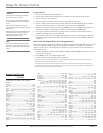
Connections & Setup
Chapter 1 11
EXTERNAL SPEAKERS
EXT/INT
LEFT
RIGHT
+
+
L/
MONO
R
Y
P
B
P
R
CMP1
CMP2
L/
MONO
R
Y
P
B
P
R
COMPONENT INPUTS
S
-
V
I
D
E
O
L/
MONO
R
V
V
ID
1
S
-
V
I
D
E
O
L/
MONO
R
V
V
ID
2
COMPOSITE INPUTS
DVI-HDTV
L/
MONO
R
Explanation of Jacks
This section describes the jacks you can use to make connections. There are several ways to connect components to your TV/DVD.
DIGITAL AUDIO OUTPUT Lets you connect a Dolby Digital receiver to your TV/DVD, if your receiver has an
optical input. Use an optical cable (or SPDIF cable) to connect your TV/DVD to the receiver for theatre-quality
sound. Go to page 30 for more information on digital audio.
Note: This TV/DVD’s OPTICAL DIGITAL OUT jack fully complies with the international standard governing this type of jack
(IEC958), and is designed for connection to a Dolby Digital (AC-3
®
or PCM) receiver or Dolby Digital (AC-3 or PCM) decoder. Older
equipment, some of which is not fully compliant with IEC958, may not be compatible with the Dolby Digital bitstream. Such a
connection using anything other than Dolby Digital AC-3 or PCM receiver or decoder could create a high noise level, causing
damage to headphones or speakers.
DVI-HDTV Input Lets you connect an HD receiver with a DVI output.
• DVI (Digital Visual Interface) Provides an uncompressed, digital video interface developed for high-
bandwidth digital connection. It supports the overlay of high-resolution graphics needed by some
electronic program guide navigation and other interactive services. DVI, when combined with HDCP (High
bandwidth Digital Content Protection) technology, creates a protected digital connection. The signal speed
of the DVI connection is 1080i for HDTV at a rate of 1.78 Gigabits per second.
• L/MONO (Audio) Provides left audio connection when using the DVI jack. The left audio connector is
usually white.
• R (Audio) Provides right audio connection when using the DVI jack. The right audio connector is usually
red.
Note: Remember to connect the left and right audio cables because the DVI cable carries only the picture signal, not the sound.
COMPONENT INPUTS Lets you connect a component video source, such as a DVD player.
• CMP1 Y, P
B
, P
R
(Component Video) Provides optimum picture quality because the video is separated into
three signals. Use three video-grade cables for the connection. When using CMP1 Y, P
B
, P
R
, make sure to
connect left and right audio cables to the CMP1 L/MONO and R Audio Input jacks.
• CMP1 L/MONO (Audio) Provides left audio connection. The left audio connector is usually white.
• CMP1 R (Audio) Provides right audio connection. The right audio connector is usually red.
• CMP2 Y, P
B
, P
R
, and L/MONO and R Audio Allows you to connect a second component video source.
Their description is the same as CMP1 above. When using CMP2 Y, P
B
, P
R
, make sure you connect the left
and right audio cables to the CMP2 Audio jacks.
COMPOSITE INPUTS Lets you connect another component such as a VCR, DVD player, or laserdisc player. Its
AUDIO jacks are the same as described for CMP1 above.
• VID1 S-VIDEO Provides better picture quality than the video jacks (VID1 and 2 Video) because the color
part of the signal is separated from the black and white part of the picture. When using VID1 S-VIDEO,
make sure to connect left and right audio cables to the VID1 L/MONO and R Audio Input jacks.
• VID1 V (Video) Provides composite video connection. The video connector is usually yellow.
• VID2 S-VIDEO, V and L/MONO and R Audio Allows you to connect a component such as a VCR, DVD
player, or laserdisc player. Their description is the same as VID1 above.
Note: Do not connect an S-Video and Video cable at the same time in either VID1 or VID2 jacks.
AUDIO/VIDEO OUTPUTS Lets you connect an amplifier or audio receiver for improved sound quality or an
external video monitor.
• FIXED AUDIO L/R Provides fixed-level audio output from the TV/DVD. This audio output is ideal for
connecting to an A/V receiver when you want to control the volume through the A/V receiver.
• VARIABLE AUDIO Provides variable-level audio output. Volume levels are controlled by the volume
controls on the TV/DVD and remote control.
• SUBWOOFER Provides lower bass audio frequencies out from the TV/DVD and to a subwoofer.
Note: If you’ve connected a subwoofer, make sure you set the External Subwoofer option in the Sound menu. Go to page 33 for
instructions.
EXTERNAL SPEAKERS
• Right and Left Speaker Terminals Let you connect external left and right speakers to the TV/DVD to
receive left and right sound.
• EXT/INT (switch) Lets you turn the TV/DVD’s internal speakers on or off. EXT sends audio to external
speakers only. INT sends audio to the TV/DVD’s internal speakers only.
ANTENNA/CABLE Lets you connect a coaxial cable to receive the signal from the antenna, cable, cable box, or
if using the examples on pages 7-9, a VCR.
AUDIO/VIDEO OUTPUT
FIXED AUDIO
VARIABLE
AUDIO
R
L
V
R
L
SUBWOOFER


















